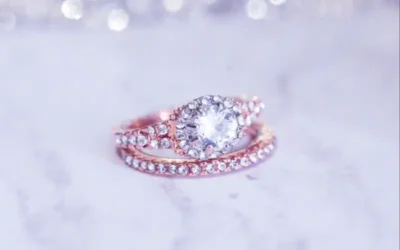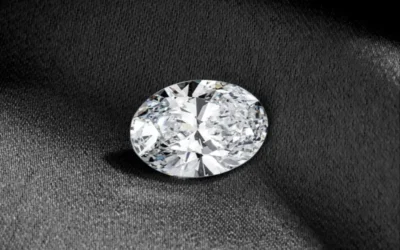What Is Lab Grown Diamond Fluorescence?
When you hold a Lab Grown Diamond under normal light, it might look like any other near-colorless gemstone—sparkling, clear, and free of any obvious quirks. But slip it under a UV lamp, and something magical can happen: a soft glow, typically blue, radiates from within. That glow is called fluorescence. In simplest terms, fluorescence is the ability of a diamond to absorb invisible ultraviolet (UV) light and re-emit it as visible light in a range of hues, most commonly blue.
Fluorescence is caused by trace impurities or structural defects in the crystal lattice. Even though lab grown diamonds are engineered in controlled environments, minute differences in temperature, pressure, or the presence of certain elements during their high-pressure high-temperature (HPHT) or chemical vapor deposition (CVD) growth can leave behind these subtle “fingerprints.” When UV photons hit the diamond, electrons in those defect sites get excited and then drop back to their original energy level, releasing visible light in the process.
While natural diamonds can fluoresce, Lab Grown Diamond fluorescence often shows more consistency in behavior, thanks to the highly controlled manufacturing processes. Yet each diamond is still unique—so understanding how fluorescence works is key to appreciating both its beauty and its impact on value.
Why Lab Grown Diamonds Fluoresce Differently
 Not all diamonds glow the same way under UV light, and Lab Grown Diamond fluorescence can differ from that of mined stones for a couple of key reasons. First, the type of UV lamp—short-wave or long-wave—can influence the intensity and color of the glow. Short-wave UV (often the bluish black lights at clubs) tends to excite fluorescence more vigorously, while long-wave UV (like some tanning beds) might elicit a gentler response.
Not all diamonds glow the same way under UV light, and Lab Grown Diamond fluorescence can differ from that of mined stones for a couple of key reasons. First, the type of UV lamp—short-wave or long-wave—can influence the intensity and color of the glow. Short-wave UV (often the bluish black lights at clubs) tends to excite fluorescence more vigorously, while long-wave UV (like some tanning beds) might elicit a gentler response.
Second, the growth method matters. In HPHT synthesis, diamonds are formed under immense pressure and heat, replicating the very conditions deep within the earth. Trace amounts of nitrogen or nickel catalysts used in HPHT can produce distinctive fluorescence patterns—sometimes stronger or more uniform than what you see in natural stones. CVD diamonds, on the other hand, grow layer by layer from a carbon-rich gas. This layered growth can introduce subtle differences in defect concentrations, often resulting in moderate to faint fluorescence.
Because manufacturers can tweak conditions with precision, Lab Grown Diamonds often exhibit more predictable fluorescence grades. Still, no two diamonds are identical, and part of the excitement is discovering how your individual stone responds under UV illumination.
Understanding Fluorescence Grades & Intensity
To bring order to the spectrum of glows, gemological labs use standardized scales. The Gemological Institute of America (GIA) grades fluorescence in five categories: None, Faint, Medium, Strong, and Very Strong. These grades are determined by viewing the diamond under a UV lamp and comparing it to master stones with known fluorescence levels.
- None: No visible fluorescence under UV light.
- Faint: Barely perceptible glow, noticeable only to trained eyes.
- Medium: Clear glow, but without overpowering brightness.
- Strong: Bright, clearly visible glow.
- Very Strong: Intense glow that may dominate the stone’s appearance under UV.
Lab Grown Diamond fluorescence tends to cluster in the Faint to Strong range, with Very Strong being less common. Because the production environment is controlled, manufacturers can aim for specific fluorescence outcomes to suit different market preferences.
Even within the same grade, two stones may glow slightly differently based on hue and uniformity. That’s why viewing real-life photos or videos, rather than relying solely on the certificate, is crucial for making an informed purchase.
Impact on Appearance & Color
Fluorescence can subtly—and sometimes dramatically—alter how a Lab Grown Diamond looks in everyday settings. In normal daylight, fluorescence is usually dormant; your diamond will appear as its graded color suggests. However, under intense sunlight or bright halogen lighting, slight UV components can awaken a gentle glow, often lending a perceived “whiteness” to near-colorless diamonds. This is why a J-color stone with Faint to Medium blue fluorescence may look whiter than its certificate suggests.
On the flip side, if your stone carries Strong to Very Strong fluorescence, there’s a small chance of a milky or hazy appearance in bright light. This phenomenon occurs when the fluorescence is so intense that it scatters light within the crystal, causing a subtle veil over the facets. Most wearers won’t notice this at a glance, but gemologists and discerning buyers sometimes see it.
In night or club environments—where short-wave UV is plentiful—fluorescent Lab Grown Diamonds can steal the show. Their blue glow contrasts beautifully against darker attire, creating an effect that’s both novel and festive. For those who love a touch of drama, fluorescence adds an extra layer of personality that natural diamonds seldom display so vividly.
Does Fluorescence Affect Price?
The relationship between fluorescence and price is nuanced. In general, diamonds with no fluorescence command a slight premium among traditional buyers who fear any alteration to their stone’s natural color. Conversely, stones graded as Strong or Very Strong may see a small discount, reflecting buyer hesitance.
Yet savvy shoppers can capitalize on this dynamic. A Lab Grown Diamond with Medium fluorescence can sometimes offer the ideal blend: enhanced perceived whiteness without risk of haziness. In such cases, retailers might price these stones more competitively, knowing that the visible value in daylight appearance often outweighs modest fluorescence concerns. Indeed, it’s not uncommon to find a J-color, Medium-fluorescent diamond that looks as white as an H-color none-fluorescent stone, all for a lower price point.
Ultimately, fluorescence can be a bargaining tool. If you know how to assess appearance under varied lighting, you can leverage fluorescence grades to find a diamond that looks better than its certificate implies—while saving money in the process.
Pros & Cons of Fluorescent Lab Grown Diamonds
Fluorescence in a Lab Grown Diamond isn’t inherently good or bad—it’s simply an optical quirk that can become either a delightful bonus or a minor drawback, depending on your priorities. Below, we dive deeply into the advantages and disadvantages, supported by real-world observations and expert insights, so you can make a fully informed choice.
Pros
- Enhanced Whiteness in Daylight
Blue fluorescence can subtly counteract yellow undertones in near-colorless grades (G–J). In practical terms, a J-color Lab Grown Diamond with Medium blue fluorescence often appears as crisp and bright as an H-color stone without fluorescence. This “daylight whitening” effect means you get the look of a higher color grade without the added cost—effectively a beauty hack baked into the crystal structure. For brides on a budget or anyone seeking maximum sparkle per dollar, that can translate into savings of 10–20% off a non-fluorescent equivalent. - Unique Personality Under UV-Rich Lighting

Think beyond the daylight sparkle: in clubs, at concerts, or even under certain LED and halogen lights, your Lab Grown Diamond can steal the show. Medium to Strong fluorescent stones emit a magical cerulean glow that feels playful and unexpected. Jewelry designers note that rings, pendants, or earrings featuring fluorescent diamonds often become conversation pieces, especially among trend-savvy consumers who appreciate a bit of “glow factor.” - Greater Availability and Competitive Pricing
Because Medium-fluorescent stones strike an appealing balance between visual impact and market acceptance, suppliers often have more inventory in these categories. That abundance naturally leads to more competitive pricing. Where a non-fluorescent G-color 1-carat stone might cost $2,500, a Medium-fluorescent equivalent could start around $2,200—saving you several hundred dollars for similar on-finger brilliance. - Stability and Predictability
Lab production allows growers to aim for specific fluorescence profiles. If you love the idea of a vibrant glow under UV but worry about extreme intensity, you can ask suppliers for Medium-Strong stones with documented performance. This level of control is less feasible with natural diamonds, making fluorescence a unique selling point for Lab Grown alternatives.
Cons
- Risk of Haze or Veiling
In rare cases, Strong or Very Strong fluorescence can scatter light within the stone, creating a “milky” or “oily” veil when viewed under diffuse, UV-rich lighting. While most wearers won’t notice this under normal conditions, gemologists spot it by comparing the diamond to a non-fluorescent master stone. If you frequently spend time in environments with strong UV sources—like some art galleries or tanning salons—that haziness may become apparent. - Buyer Misconceptions and Resale Considerations
Despite industry consensus that fluorescence doesn’t affect durability, some consumers mistakenly equate it with inferior quality. If you think you may resell your Lab Grown Diamond later, be aware that certain second-hand buyers or traditional jewelers might discount fluorescence grades more steeply, even when Medium fluorescence enhances appearance. - Variable Impact by Setting
The way fluorescence shows up can depend on your chosen jewelry setting. Closed-back designs (like bezel mounts) block UV light, muting the glow, whereas open prongs maximize exposure. If your goal is a consistent glow, you’ll need to factor setting style into your purchase decision—and possibly pay a little extra for a more open design. - Subjectivity of Aesthetics
Ultimately, fluorescence is an aesthetic preference. What looks dreamy and ice-white to one person might read as too bright or “unnatural” to another. Even within the same Medium-fluorescent grade, variations in hue (from icy blue to pale green) can affect how the glow is perceived. Personal taste plays a major role, so it’s essential to see your exact stone under UV before committing.
How to Evaluate Fluorescence When Buying
Evaluating fluorescence isn’t just a checkbox on a lab report—it’s a hands-on process that ensures your Lab Grown Diamond lives up to both its certificate and your expectations. Here’s an in-depth guide to assessing fluorescence at every stage of the buying journey.
- Start with Certification Details
- Lab Report Verification: Confirm that your GIA, IGI, or other reputable report explicitly lists fluorescence grade (None, Faint, Medium, Strong, Very Strong). Note whether the report mentions fluorescence hue—most often blue, but occasionally yellow, green, or white.
- Understand Tolerance Ranges: Labs allow slight variation within each grade. A diamond at the upper threshold of “Medium” may glow more intensely than one at the lower end, so use the certificate as a starting point, not the final word.
- Request Comprehensive Visuals
- Daylight and Indoor Lighting: Ask for high-resolution photos or videos under pure daylight and standard indoor lighting (halogen or LED). These views reveal how the diamond’s body color interacts with any fluorescence effect.
- UV-Light Showcase: Insist on images under a short-wave UV lamp (254 nm) and, if possible, a long-wave lamp (365 nm). Comparing both shows you the full extent of glow intensity and potential hue shifts.
- In-Person Inspection Is Gold
- Bring Your Own UV Light: If you can, purchase a small UV flashlight (under $20) and use it in the showroom. This lets you preview the stone’s glow in situ, ensuring you’re not relying solely on retail lighting setups.
- Compare Side-by-Side: Examine a non-fluorescent and a fluorescent stone of the same color grade. Holding them side by side under identical lighting reveals how much fluorescence is influencing perceived whiteness.
- Consider Settings and Wear Scenarios
- Setting Mock-Ups: Try on sample rings or pendants with closed-back and open-prong settings. Notice how the stone’s face-up appearance changes—some settings can mute fluorescence, others amplify it.
- Lifestyle Lighting Audit: Reflect on your daily environments. If you work in a bright office or spend weekends outdoors, Medium fluorescence can boost everyday brilliance. If you frequent nightlife scenes, Strong fluorescence might become your signature look.
- Leverage Expert Opinion
- Consult a Trusted Jeweler: An experienced bench jeweler can show you fluorescence in controlled UV settings and advise on mountings that suit your preferences.
- Third-Party Appraisals: For high-value purchases, consider sending the diamond to a gem lab that offers fluorescence photography services. These standardized images provide a benchmark you can revisit for insurance or resale.
By combining objective data (lab reports) with subjective testing (photos, UV lights, personal wear), you gain a 360° understanding of how fluorescence will perform in your life. Armed with this knowledge, you can confidently select a Lab Grown Diamond that not only shines on paper but also delights you every time it catches the light.
Common FAQs on Lab Grown Diamond Fluorescence
Will my ring glow at weddings or under club lights?
Many wedding venues and clubs use lighting that contains UV components. If your diamond has Medium to Strong fluorescence, you’ll likely notice a gentle glow when the DJ hits the black-light. In most formal events under pure daylight or incandescent lighting, fluorescence remains subtle or invisible.
 Is strong fluorescence a red flag?
Is strong fluorescence a red flag?
Not inherently. Strong fluorescence can create a milky sheen in rare cases, but most stones labeled Strong under GIA standards still appear crisp in daily wear. Always view the diamond yourself—don’t judge based solely on the word “Strong.”
How often do lab-grown diamonds fluoresce?
Approximately 25–35% of Lab Grown Diamonds exhibit noticeable fluorescence, with the majority falling in the Faint to Medium categories. Very Strong fluorescence is less common but not unheard of.
Does fluorescence impact durability or wear?
Fluorescence has no bearing on a diamond’s hardness, toughness, or wear resistance. It’s purely an optical phenomenon; the crystal lattice remains just as robust regardless of glow.
Conclusion & Buying Tips
Fluorescence in Lab Grown Diamonds is a feature worth understanding—not fearing. From subtle daylight brightening to eye-catching nighttime glow, fluorescence adds a layer of personality to your stone. To recap: fluorescence occurs when UV light interacts with trace defects, yielding a visible glow graded from None to Very Strong. It can enhance perceived whiteness, especially in near-colorless diamonds, and offers unique aesthetic flair under UV-rich lighting.
When shopping, prioritize visual evidence: ask for photos in varied lighting, examine the stone in person if possible, and verify the fluorescence grade on a reputable lab report. Consider how you’ll wear the piece and whether you want the surprise of a faint glow or the drama of a stronger flash. By combining technical knowledge with personal taste, you’ll choose a Lab Grown Diamond that not only fits your budget but also feels like it was made just for you.
Armed with these insights, you’re ready to navigate the world of Lab Grown Diamond fluorescence with confidence—and perhaps even a bit of delight when your stone lights up under the right moment. Happy hunting!






